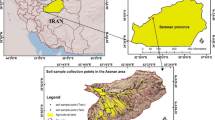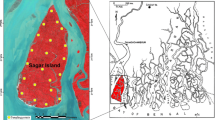Abstract
Dynamic and vigorous top soil is the source for healthy flora, fauna, and humans, and soil organic matters are the underpinning for healthy and productive soils. Organic components in the soil play significant role in stimulating soil productivity processes and vegetation development. This article deals with the scientific demand for estimating soil organic carbon (SOC) in forest using geospatial techniques. We assessed distribution of SOC using field and satellite data in Sariska Tiger Reserve located in the Aravalli Hill Range, India. This study utilized the visible and near-infrared reflectance data of Sentinel-2A satellite. Three predictor variables namely Normalized Difference Vegetation Index, Soil Adjusted Vegetation Index, and Renormalized Difference Vegetation Index were derived to examine the relationship between soil and SOC and to identify the biophysical characteristic of soil. Relationship between SOC (ground and predicted) and leaf area index (LAI) measured through satellite data was examined through regression analysis. Coefficient of correlation (R 2) was found to be 0.95 (p value < 0.05) for predicted SOC and satellite measured LAI. Thus, LAI can effectively be used for extracting SOC using remote sensing data. Soil organic carbon stock map generated through Kriging model for Landsat 8 OLI data demonstrated variation in spatial SOC stocks distribution. The model with 89% accuracy has proved to be an effective tool for predicting spatial distribution of SOC stocks in the study area. Thus, optical remote sensing data have immense potential for predicting SOC at larger scale.





Similar content being viewed by others
References
Barnes EM, Sudduth KA, Hummel JW, Lesch SM, Corwin DL, Yang C, Daughtry CST, Bausch WC (2003) Remote- and ground-based sensor techniques to map soil properties. Photogramm Eng Remote Sens 69(6):619–630
Black CA (1965) Hydrogen-ion Activity. Methods of soil analysis part II: chemical and microbiological properties. America Society of Agronomy, Madison, pp 771–1572
Brown S (1997) Estimating biomass and biomass change of tropical forests. FAO Forest Resources Assessment Publication, Rome, p 55
Campbell GS, Norman JM (1998) An introduction to environmental biophysics. Springer, New York, p 268
Choudhury BJ, Ahmed AH, Idso SB, Reginato RJ, Daughtry CST (1994) Relations between evaporation coefficients and vegetation indices studied by model simulations. Remote Sens Environ 50:1–17
Gao BC, Goetz AFH (1990) Column atmospheric water vapor and vegetation liquid water retrievals from airborne imaging spectrometer data. J Geophys Res 95:3549–3564
Grossman RB, Reinsch TG (2002) The solid phase: 2.1. In: Bulk density and linear extensibility: methods of soil analysis, part 4; Soil Science Society of America Madison, Madison, WI, USA, pp 201–225
Gullison RE, Frumhoff PC, Canadell JG, Field CB, Nepstad DC, Hayhoe K, Avissar R, Curran LM, Friedlingstein P, Jones CD (2007) Tropical forests and climate policy. Science 316:985–986
Gupta G, Singh J, Pandey PC, Tomar V, Rani M, Kumar P (2014) Geospatial strategy for estimation of soil organic carbon in tropical wildlife reserve. In: Srivastava P, Mukherjee S, Gupta M, Islam T (eds) Remote sensing applications in environmental research. Society of earth scientists series. Springer, Cham, pp 69–83
Houghton RA, Hall F, Goetz S (2009) Importance of biomass in the global carbon cycle. J Geophys Res 114:1–13
Huete AR (1988) A soil-adjusted vegetation index (SAVI). Remote Sens Environ 25:295–309
Jain P, Sajjad H (2016a) Analysis of willingness for relocation of the local communities living in the Critical Tiger Habitat of the Sariska Tiger Reserve, India. Local Environ 21(11):1409–1419
Jain P, Sajjad H (2016b) Household dependency on forest resources in the Sariska Tiger Reserve (STR), India: Implications for management. J Sustain For 35(1):60–74
Jain P, Ahmed R, Sajjad H (2016) Assessing and monitoring forest health using a forest fragmentation approach in Sariska Tiger Reserve, India. J Geogr 70(5):306–315
Kumar P, Singh BK, Rani M (2013) An efficient hybrid classification approach for land use/land cover analysis in a semi-desert areausing ETM+ and LISS-III sensor. IEEE Sens J 13(6):2161–2165
Kumar P, Tomar V, Srivastava P, Singh J, Gupta G (2014) Geospatial approach for carbon sink in the timbered biomass for tropical wildlife reserve. Asian J Geoinform 14(1):1–7
Kumar P, Pandey PC, Kumar V, Singh BK, Tomar V, Rani M (2015) Efficient recognition of forest species biodiversity by inventory-based geospatial approach using LISS IV sensor. IEEE Sens J 15(3):1884–1891
Kumar P, Pandey PC, Singh BK, Katiyar S, Mandal VP, Rani M, Tomar V, Patairiya S (2016) Estimation of accumulated soil organic carbon stock in tropical forest using geospatial strategy. Egypt J Remote Sens Space Sci 19(1):109–123
Maynard CL, Lawrence RL, Nielsen GA, Decker G (2007) Modeling vegetation amount using bandwise regression and ecological site descriptions as an alternative to vegetation indices. GISci Remote Sens 44:68–81
McBratney AB, Mendonca Santos ML, Minasny B (2003) On digital soil mapping. Geoderma 117:3–52
Neigh CSR, Bolton DK, Diabate M, Williams JJ, Carvalhais N (2014) An automated approach to map the history of forest disturbance from insect mortality and harvest with Landsat Time-Series data. Remote Sens 6:2782–2808
Oliver MA (1990) Kriging: a method of interpolation for geographical information systems. Int J Geogr Inf Syst 4:313–332
Pandey PC, Tate NJ, Balzter H (2014) Mapping tree species in coastal portugal using statistically segmented principal component analysis and other methods. IEEE Sens J 14(12):4434–4441
Powell SL, Cohen WB, Healey SP, Kennedy RE, Gretchen GM, Pierce KB, Ohmann JL (2010) Quantification of live aboveground forest biomass dynamics with Landsat time-series and field inventory data: a comparison of empirical modeling approaches. Remote Sens Environ 114:053–1068
Qi J, Chehbouni A, Huete AR, Kerr YH, Sorooshian S (1994) A modified soil vegetation adjusted index. Remote Sens Environ 48(2):119–126
Richardson AJ, Wiegand CL (1977) Distinguishing vegetation from soil background information. Photogramm Eng Remote Sens 43:1541–1552
Selige T, Böhner J, Schmidhalter U (2006) High resolution topsoil mapping using hyperspectral image and field data in multivariate regression modelling procedures. Geoderma 136(1–2):235–244
Tekin Y, Tumsavas Z, Mouazen AM (2012) Effect of moisture content on prediction of organic carbon and pH using visible and near-infrared spectroscopy. Soil Sci Soc Am J 76:188–198
Tomar V, Kumar P, Rani M, Gupta G, Singh J (2013) A satellite-based biodiversity dynamics capability in tropical forest. Electron J Geotech Eng 18:1171–1180
Tomar V, Mandal VP, Srivastava P, Patairiya S, Singh K, Ravisankar S, Natesan N, Kumar P (2014) Rice equivalent crop yield assessment using MODIS sensors’ based MOD13A1-NDVI data. IEEE Sens J 14(10):3599–3605
Vagen TG, Winowiecki LA (2013) Mapping of soil organic carbon stocks for spatially explicit assessments of climate change mitigation potential. Environ Res Lett 8:1748–1793
Wu CY, Jacobson AR, Laba M, Baveye PC (2009) Alleviating moisture content effects on the visible near-infrared diffuse-reflectance sensing of soils. Soil Sci 174:456–465
Zheng D, Rademacher J, Chen J, Crow T, Bresee M, Le Moine J, Ryu S (2004) Estimating aboveground biomass using Landsat 7 ETM+ data across a managed landscape in Northern Wisconsin, USA. Remote Sens Environ 93:402–411
Author information
Authors and Affiliations
Corresponding author
Rights and permissions
About this article
Cite this article
Kumar, P., Sajjad, H., Tripathy, B.R. et al. Prediction of spatial soil organic carbon distribution using Sentinel-2A and field inventory data in Sariska Tiger Reserve. Nat Hazards 90, 693–704 (2018). https://doi.org/10.1007/s11069-017-3062-5
Received:
Accepted:
Published:
Issue Date:
DOI: https://doi.org/10.1007/s11069-017-3062-5




